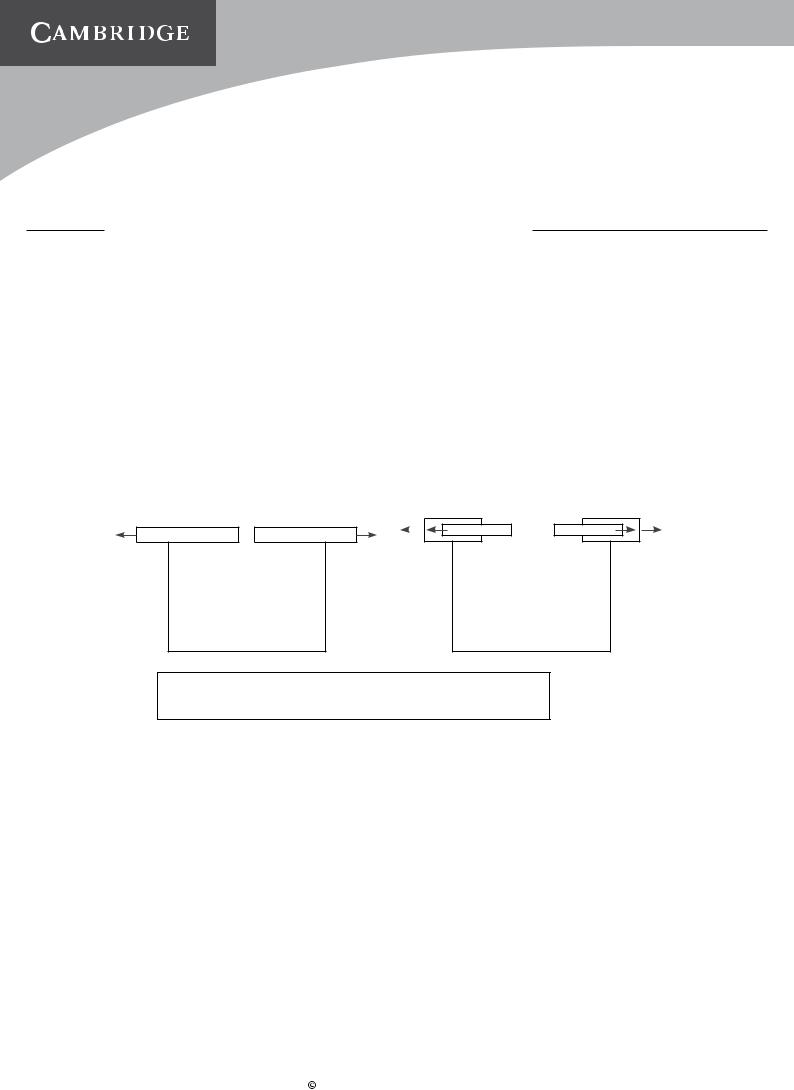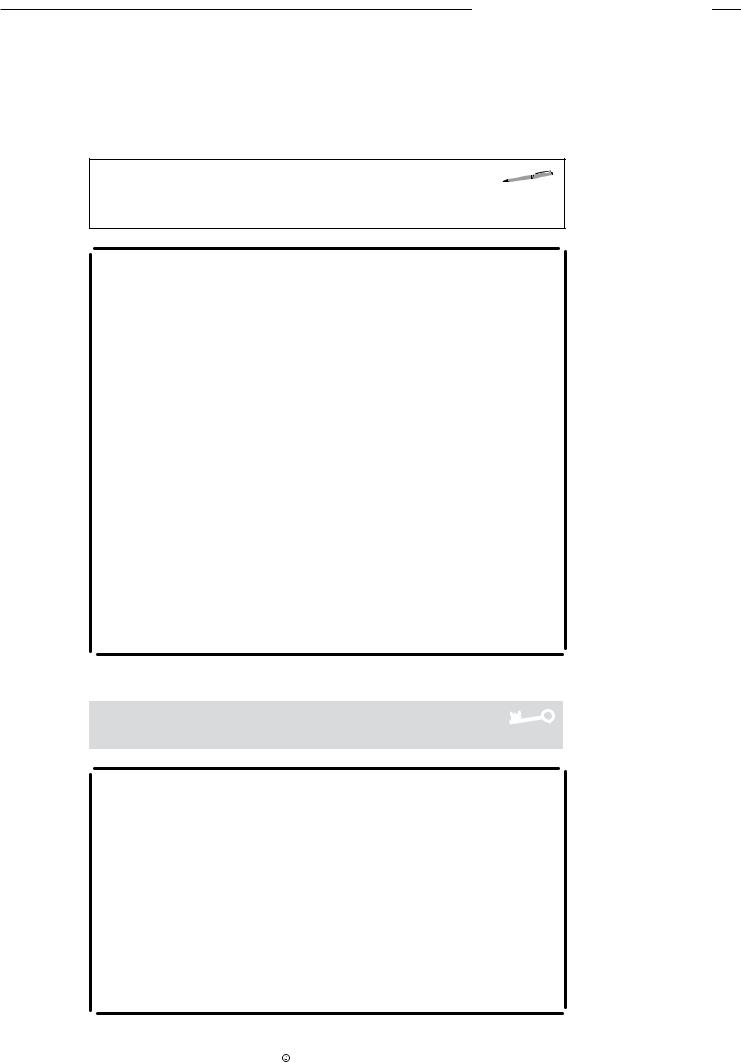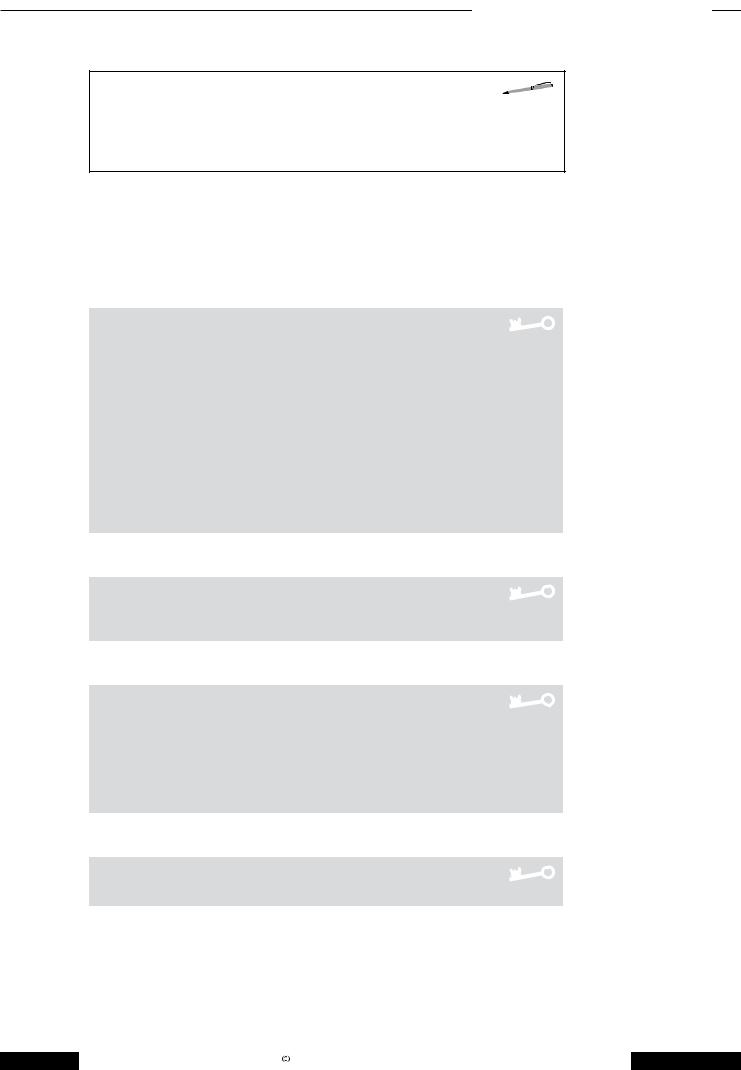
Keys Cambridge English for Engineering Teachers Notes
.pdf
UNIT 1 Technology in use Teacher’s Notes
Emphasising technical advantages (pages 10 and 11)
This section reflects the importance of constant technical improvement and innovation in a commercially competitive environment, a concept which is at the heart of all branches of engineering. The underlying aim is to help students emphasise technical advantages, and to sell their ideas, whether to clients, superiors or colleagues. The theme – cutting-edge lift technology at Otis – provides both modern and historic interest in terms of promoting technological progress.
Lifts http://en.wikipedia.org/wiki/Elevator
http://www.youtube.com/watch?v=LblD4i2Dq4w http://www.youtube.com/watch?v=DkWkgoeLZzU&feature=related http://www.youtube.com/watch?v=wOacMrrieh4&feature=related
Simplifying and illustrating technical explanations (pages 12 and 13)
Engineers who specialise in specific technical fields often liaise with colleagues from other branches of engineering, and frequently have to deal with generalist project managers, and non-technical superiors and customers. In such cases, it is essential to be able to explain and illustrate technical concepts in clear, simple terms. This section focuses on this important skill. It should be noted that the specialised terms for describing pile foundations in this section are dealt with, not as target language, but to exemplify the phrases and techniques used for simplifying and illustrating technical terminology.
|
Cambridge English for Engineering |
Cambridge University Press 2008 |
|
|
11 |
Photocopiable |
|||
www.cambridge.org/elt/englishforengineering |
||||
|
|
|||

Professional English
Cambridge English for
Engineering
UNIT 1 Technology in use TEACHER’S NOTES
 Resource sheet 1a
Resource sheet 1a
Make notes on the product you have chosen to help you describe it to your partner.
Name of product |
Application |
Functions and features |
|
(what the product is used for) |
(what the product does and has) |
Useful language |
The product’s main use is ... |
(The product) enables you to ... |
||
|
The main users of the product are ... |
(The product) allows you to ... |
||
|
The product is used to ... |
(This feature) ensures that ... |
||
|
It’s used for ... |
ing |
(This feature) prevents ... |
from ...ing |
|
It’s useful for ... |
ing |
|
|
12 |
Cambridge English for Engineering |
Cambridge University Press 2008 |
Photocopiable |
|
www.cambridge.org/elt/englishforengineering |
||||
|
|
|||

Professional English
Cambridge English for
Engineering
UNIT 1 Technology in use TEACHER’S NOTES
 Resource sheet 1b
Resource sheet 1b
The concepts below have been introduced over the years to enhance the operation of lifts. With a partner, describe the advantages offered by each system.
1Equip the lift car with an alarm button and an intercom system.
2Equip the lift car with air-conditioning.
3Instead of installing one large lift, install two smaller lifts, side by side, which run independently but are both managed by the same call buttons in the lobby on each floor of the building.
4In very tall buildings, instead of having lifts which run the full height of the building, have two levels of lifts, with the first level serving the bottom half of the building, and the second level serving the top half.
5Instead of using a system of 2 sliding doors, 4 sliding doors are used, as below.
2-door system |
|
|
|
|
|
4-door system |
|
|
||||
|
|
|
|
|
|
|
|
|
|
|
|
|
|
|
|
|
|
|
|
|
|
|
|
|
|
|
|
|
|
|
|
|
|
|
|
|
|
|
|
|
|
|
|
|
|
|
|
|
|
|
|
Lift car |
Lift car |
Useful language
This enhances ... This reduces ... This eliminates ... This offers superior ...
|
Cambridge English for Engineering |
Cambridge University Press 2008 |
|
|
13 |
Photocopiable |
|||
www.cambridge.org/elt/englishforengineering |
||||
|
|
|||

Professional English
Cambridge English for
Engineering
UNIT 1 Technology in use TEACHER’S NOTES
 Resource sheet 1c
Resource sheet 1c
Make notes on the product or type of technology to help you describe it to your partner.
Technology |
Function |
Comparison with an everyday concept |
Useful language |
This is what we call a ... This is what we refer to as a ... |
|
|
Basically/Effectively/Essentially , it’s (like) a ... |
|
|
In other words ... |
In simple terms ... Put simply ... |
|
If you imagine a ... |
If you picture a ... |
|
Cambridge English for Engineering |
Cambridge University Press 2008 |
|
|
14 |
Photocopiable |
|||
www.cambridge.org/elt/englishforengineering |
||||
|
|
|||

Professional English
Cambridge English for
Engineering
TEACHER’S NOTES
UNIT 2 Materials technology
•Describing specific materials
•Categorising materials
•Specifying and describing properties
•Discussing quality issues
 Go to page 25 for essential background information and useful web links.
Go to page 25 for essential background information and useful web links.
 Describing specific materials
Describing specific materials
Before you begin …
Ask students to suggest some examples of materials widely used in engineering. Ask students what is meant by recycling. How does recycling affect engineering design?
Answer
Increasingly, engineers need to design in recycling – planning for how assemblies will be disposed of.
Language note
You will find the following vocabulary useful in this section.
aluminium, bronze, copper, glass, lead, iron, ore, plastic, rubber, steel, stainless steel, timber, hardwood, softwood, zinc
1 Students complete the task in pairs.
Suggested answers
Scrapping cars
A lot of metal, notably steel, can be recycled. Intact parts can be recovered and resold. Oil, brake fluid and battery acid are potential pollutants which need to be disposed of carefully. Tyres are more difficult to recycle.
Recycling electronics
Heavy metals such as lead, cadmium and chromium are potential pollutants and can also be recovered for recycling. The process of recycling electronic products is quite difficult due to the difficulty of breaking up and separating very small components.
Breaking up ships
Large amounts of steel can be recovered and recycled. Main pollutants are fuel oil from tanks and asbestos which was widely used as an insulation material inside ships.
Demolishing buildings
Structural steel can be recycled, concrete can be crushed and reused, for example in asphalt for road surfacing, copper in electrical wires can be recovered and recycled, good-quality bricks can sometimes be cleaned and reused. As with ships, asbestos is often found, requiring special precautions for its removal. The main difficulty is the time taken to demolish buildings meticulously.
15 |
Cambridge English for Engineering |
Cambridge University Press 2008 |
Photocopiable |
|
www.cambridge.org/elt/englishforengineering |
||||
|
|
|||

UNIT 2 Materials technology Teacher’s Notes
2 a Students complete the headings.
Answers |
|
|
|
2 |
Glass |
5 |
Timber |
3 |
Copper |
6 |
Rubber |
4 |
Aluminium |
7 |
Plastic |
|
|
|
|
Language note
British English = aluminium /{ljUmIni@m/ American English = aluminum /
@lumIn@m/
Extension activity: more vocabulary
You could look at the meaning of some of the terms in Exercise 2a in more detail. magnetism = force of attraction
galvanised = coated with zinc (Zn) to prevent rusting recyclable = can be recycled
chromium (Cr) and nickel (Ni) = metals added to steel to make stainless steel traces = small quantities
scarcity = limited availability/rarity
insulation = both electrical insulation and thermal insulation wire = single strand of metal
scrap = waste material intended for recycling
alloy = a mixture of metals sometimes containing a non-metal, for example carbon (C) in steel
brass = an alloy of copper (Cu), zinc and, often, lead (Pb) bronze = an alloy of copper and tin (Sn)
melting down = using heat to change the state of a substance from solid to liquid energy-intensive = using a lot of energy
electrolysis = passing an electrical current through a liquid or solid in order to separate chemical compounds
ore = mineral from which metal is extracted hardwood = timber from deciduous trees softwood = timber from pine trees
ironmongery = collective term for small metal items commonly used in buildings, for example door handles, hinges, screws, nails
b Students match the words and definitions.
Answers
2 a 3 b 4 f 5 d 6 h 7 e 8 g
Extension activity: pronunciation
Give students Resource sheet 2a and ask them to decide whether the sounds of the sections in bold are the same or different. Check the pronunciation together.
Answers
2ore; or = same
3stainless /ləs/ steel; less /les/
4galvanised / g{lv@nA zd/;van /v{n/
5wood /wυd/; food /fu d/
6zinc; think = same
7nickel /nIk@l/; well /wel/
8chromium / kr@Umi@m/; from /frɒm/
9lead /led/; lead /li d/
|
Cambridge English for Engineering |
Cambridge University Press 2008 |
|
|
16 |
Photocopiable |
|||
www.cambridge.org/elt/englishforengineering |
||||
|
|
|||

UNIT 2 Materials technology Teacher’s Notes
c Students complete the sentences.
Answers |
|
|
|
2 |
with |
6 |
of |
3 |
from |
7 |
of |
4 |
from |
8 |
from |
5 |
with |
|
|
|
|
|
|
d
3 a
Students complete the task in pairs. Students could focus on the materials mentioned on the webpage on page 14, or other familiar materials. You could give students Resource sheet 2b for extra help.
Check students’ understanding of environmentally friendly design (= designing with environmental protection in mind), for example recycling, energy efficient, avoiding pollution. Students discuss the ideas in pairs.
b
c
2.1 Students listen and complete the task.
Answers
The main point that Irina makes is that it’s important to consider the total environmental impact of a product, including producing it (pre-use), using it (inuse) and recycling it (post-use). She gives the example of an energy-saving light bulb.
2.2 Students listen and make notes.
Answers
Sophia and Pete’s ideas:
Pre-use: aluminium production (extraction from ore and recycling), coating steel (galvanising), transporting and handling bulk material, cutting and welding In-use: weight (impact on fuel consumption), lifespan (frequency of manufacturing)
d Students complete the task in pairs. Students could look at audioscript 2.2 for extra help and use the conversation as a model.
Suggested answers
Electrical wires in vehicles
For pre-use, as far as I know, it takes more energy to produce aluminium than to produce copper, if it’s derived from ore. However, it takes less energy to transport aluminium, because it’s lighter.
For in-use, I’m sure aluminium is better because it’s lighter, so the vehicle would consume less fuel.
For post-use, both aluminium and copper can be recycled. I’d say it takes less energy to handle and transport aluminium, because it’s lighter.
External walls in houses
For pre-use, it takes a lot of energy to produce bricks because they have to be fired in a kiln. They’re also heavy to transport. Softwood is lighter to transport, and I’d say it probably takes less energy to saw it and handle it, compared with making bricks. During construction, building with bricks uses more energy, as sand and cement have to be transported and mixed to make mortar.
For in-use, wood is a better insulator than brick which is an advantage, as the house should take less energy to heat. In theory, softwood could last as long as bricks, if it’s properly maintained. But in practice, that will often not be the case. So, construction energy could sometimes be higher for softwood, as houses need to be rebuilt more often.
For post-use, it’s possible to recover both bricks and softwood for re-use, but neither is very easy to recycle.
17 |
Cambridge English for Engineering |
Cambridge University Press 2008 |
Photocopiable |
|
www.cambridge.org/elt/englishforengineering |
||||
|
|
|||

UNIT 2 Materials technology Teacher’s Notes
 Categorising materials
Categorising materials
Language note
You will find the following vocabulary useful in this section.
compound, exotic (material), ferrous, non-ferrous, ceramic, alloy, metallic, nonmetallic, polymer
consist of, comprise, made of, made from, made out of
Before you begin …
Ask students to explain what is meant by categorising materials (= putting materials into different categories/types). Ask students to give some examples of different categories of materials and one or two specific materials to illustrate each category, for example metals – steel and copper.
4 Students complete the task in pairs.
Suggested answers
1Brakes are designed to slow down vehicles or moving parts. Often they
work through friction, by applying pressure to pads which are pressed against the sides of a disc, the inside of a drum, or directly against a wheel rim. Alternatives include systems that use electromagnetic force, systems that exploit the braking effects of engines or flywheels (via clutches and gearboxes), aerodynamic braking systems (for example spoilers on aircraft, parachutes on dragsters), and reverse thrusters on jet engines. Brake discs are often made
of ferrous metals (iron-based – for example steel), or sometimes ceramic materials.
2Examples of materials used to make pads include: compounds of advanced materials (cars), ferrous metals (trains), rubber (bicycles), ceramics (performance cars).
5 a Students read the article and answer the question.
Answers
Green refers to ecological issues. Red refers to heat (red hot means very hot). Also, a hot topic is a current important topic.
b Students complete the task in pairs.
Answers
1Because they use friction, which wastes energy as heat
2They recover heat and use it to power the car.
3The ability to generate high levels of friction, and to resist the effects of friction and consequent heat
4Heat from the engine being absorbed by the chassis, which can damage sensitive parts such as electronic components and plastic parts
c Students match the materials and descriptions.
Answers
2 g 3 b 4 f 5 d 6 a 7 e
18 |
Cambridge English for Engineering |
Cambridge University Press 2008 |
Photocopiable |
|
www.cambridge.org/elt/englishforengineering |
||||
|
|
|||

UNIT 2 Materials technology Teacher’s Notes
Extension activity: metals (Resource sheet 2c)
Give students Resource sheet 2c. Students complete the table in pairs.
Answers
Metals: bronze, copper, iron, steel
Alloys: bronze, steel
Non-metals: glass, nylon, synthetic rubber
Ferrous metals: iron, steel
Non-ferrous metals: aluminium, bronze, copper
Polymers: nylon, synthetic rubber
Ceramics: glass
Extension activity: more vocabulary
You could look at the meaning of some of the terms in Exercise 5a in more detail. automotive = related to vehicle design and manufacturing
kinetic energy = energy in the form of movement, for example a spinning wheel deceleration = reducing speed
acceleration = increasing speed
asbestos = a fibrous material derived from rock that was used as an insulating material; it is no longer used as it damages the lungs if the fibres are inhaled composite = combined materials, consists of a bulk material called a matrix, reinforced with fibres or bars, for example glass-reinforced plastic = plastic matrix with glass fibres
non-hazardous = not dangerous
exhaust = system for evacuating smoke or gases, for example from an engine
d
6a b
c d
Students complete the task in pairs.
Students complete the task.
Students complete the task in small groups.
Before you begin …
Look at the meaning of the following terms.
insulation = a protective material which does not conduct electricity
waterproof membrane = thin layer of material which acts as a barrier to prevent water passing
armoured = covered with a very strong protective layer conductor = material which conducts electricity
Students complete the task.
2.3 Students listen and check their answers to Exercise 6c.
Answers
1 c 2 b 3 d 4 a 5 e
e Students match the parts of the cable and the materials. Students can use audioscript 2.3 for extra help.
Answers
1 b; c 2 d; e 3 d 4 e 5 a; b; c
7 Students complete the task in pairs or small groups.
19 |
Cambridge English for Engineering |
Cambridge University Press 2008 |
Photocopiable |
|
www.cambridge.org/elt/englishforengineering |
||||
|
|
|||

UNIT 2 Materials technology Teacher’s Notes
 Specifying and describing properties
Specifying and describing properties
Language note
You will find the following vocabulary useful in this section.
elasticity, toughness, abrasion resistance, thermal stability, lightweight, durable ideally, obviously, the key requirement, the last thing you want is …, a good degree of …
8a b c
Before you begin …
Ask students to explain what is meant by properties of materials and to give some examples of properties of specific materials, for example steel (tough), polystyrene (lightweight).
Students complete the task in pairs.
Students read the article in pairs and compare their answers in Exercise 8a.
Students find the words in the text to match the definitions.
Answers
2abrasion resistance
3thermal stability
4durable
5lightweight
Extension activity: adjectives and nouns (Resource sheet 2d)
Give students Resource sheet 2d. Students complete the table in pairs. You could also look at rigid and rigidity, as opposites of elastic/flexible, elasticity/flexibility.
Answers |
|
|
|
1 |
toughness |
7 |
fragile; fragility |
2 |
elastic; elasticity |
8 |
flexible; flexibility |
3 |
abrasion-resistant; abrasion resistance |
9 |
heavy; heaviness |
4 |
thermally stable; thermal stability |
10 |
brittle; brittleness |
5 |
durable; durability |
11 |
rigid; rigidity |
6 |
light; lightness |
|
|
9 a Students match the automotive parts and descriptions.
Answers
1 c 2 e 3 b 4 a 5 d
b Students complete the extract.
Answers |
|
|
|
1 |
tyres |
4 |
bullet-resistant armour |
2 |
drive belts |
5 |
sealing gaskets |
3 |
brake pads |
|
|
20 |
Cambridge English for Engineering |
Cambridge University Press 2008 |
Photocopiable |
|
www.cambridge.org/elt/englishforengineering |
||||
|
|
|||
